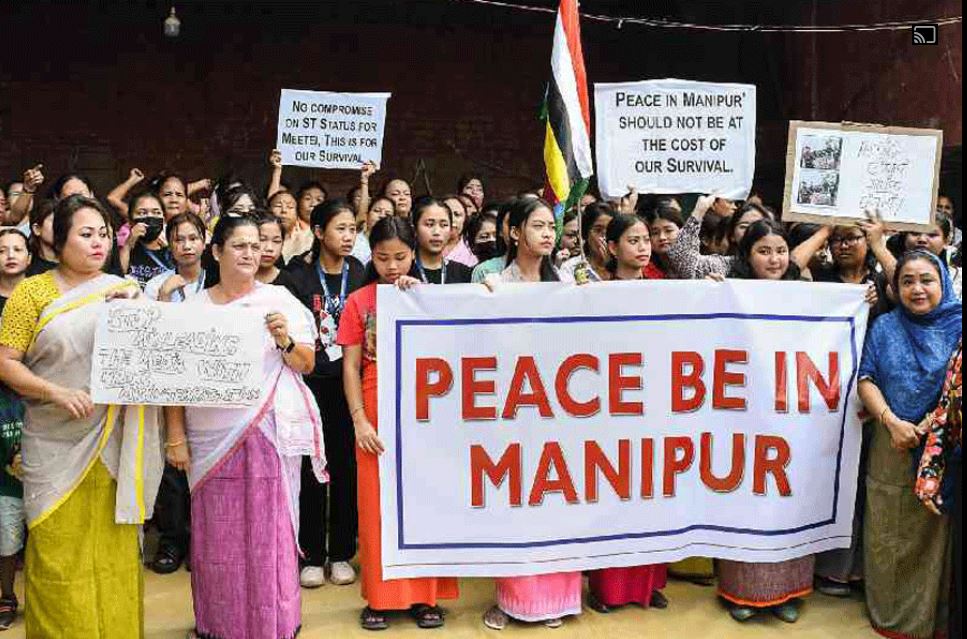This has to be one of Manipur’s darkest times. One of those chilling moments of discovery Joseph Conrad warned of in “Heart of Darkness” – if you look deep enough into your own soul, beneath the veneer of civilisation, there is dark menacing madness. It is unbelievable how a solidarity rally of Kukis and Nagas, two of Manipur’s major ethnic groups, to oppose a proposal to include Meiteis, the third and largest ethnic group of the state, in the Schedule Tribe list, could explode into a murderous frenzy for two days between Kukis and Meiteis in several townships, leaving a trail of deaths and destructions.
In a very Freudian sense, what was witnessed is also that the retreat or return of order became reciprocal to the absence or presence of the state’s show of legitimate force, as if in demonstration that dark instinctual forces within needed constant moderation, if not by the society’s own rational self then by the forceful authority of civilisational norms.
The tussle over Meitei’s inclusion in the ST list, should have been fought in the court of law only. Even if it were to be on the streets, it ought to have been between the state and those opposed to the state’s decision on the matter.
The state had taken no decision on the demand for over 10 years, probably because not all Meiteis wanted it and also in anticipation of opposition from those already in the list who their own slice of the reservation pie would get thinner. They also fear that once recognized as STs, Meiteis would begin grabbing land in the hills, considered exclusive territory of tribals. This reasoning however is flawed, for even among existing tribal communities, encroachment into each other’s traditional territorial domains is not possible. The bloody Kuki-Naga conflict in Manipur in the 1990s when Nagas began a campaign of evicting Kuki villages established in territories Nagas considered as theirs, is loud evidence of this.
Meitei’s stated reason for wanting ST status is, prevention of their land marginalisation in. A peculiarly skewed land revenue administration inherited from colonial times separates revenue flatlands from non-revenue hills in Manipur. While everybody can settle in the central Imphal valley – Meitei’s traditional home forming 10 percent of the state’s area – Meiteis are given no right to settle in the hills constituting 90 percent of the state. As land pressure mounted with population growth, an increasing sense of siege amongst Meiteis was inevitable. Though it is unlikely Meiteis would be eager to settle in the hills even if they were free to do so, the very knowledge that they are prohibited to do so heightened their claustrophobia.
It should also not be difficult to understand Meitei’s sense of injustice at the absence of a creamy layer clause in the existing ST reservation, for they keep seeing ST colleagues from similar or better educational and economic backgrounds given preference at job entry points, promotional avenues, tax exemption etc.
Things took a new turn on April 19. Responding to a petition, the Manipur High Court directed the state government to forward its recommendation on the Meitei case to the Union government. The May 3 rally of Nagas and Kukis was a response to this. The spark for the explosion came from Churachandpur, dominated by Kuki aligned tribes, but no spark would have meant much if there were no dry tinder to burn and intriguingly, this tinder seemed there only in the case of Kukis not Nagas.
Like Meiteis suffering a siege mentality, circumstances have made Kukis suffer from a sense of persecution. In recent times, a long shelved narrative that they are nomadic migrants again began being pushed from certain quarters. It is true that because of a peculiar land holding tradition, Kuki villages have a tendency to proliferate, often causing frictions with their neighbours. Under the circumstance, even normal government initiatives like eviction drives from reserved forests, fight against the new menace of poppy plantation, push for citizenship registration etc., came to be seen as targeting Kukis. The unfortunate explosion of tempers on May 3 at Chrachandpur which spread to cause a carnage is a result. The absence of timely government intervention made things worse. By last official count, there are 71 bodies deposited at the state’s mortuaries, and 41 of these died in the riots.
The article was first published in The Telegraph. The original can be read HERE











1 thought on “Manipur Penetrating Deeper and Deeper Into the Heart of Darkness”
I appreciate the articulate presentation.
The recent video of mob parading two women have been interpreted in different ways by various CSOs, media houses, intellectuals and activists. COCOMI has rejected the claim that they were raped. The comment of PM, the responses to the comment, and the general discussion revolving around the incident has been confusing. Can you also please analyse the matter? I would like to read your opinion on this.
Comments are closed.